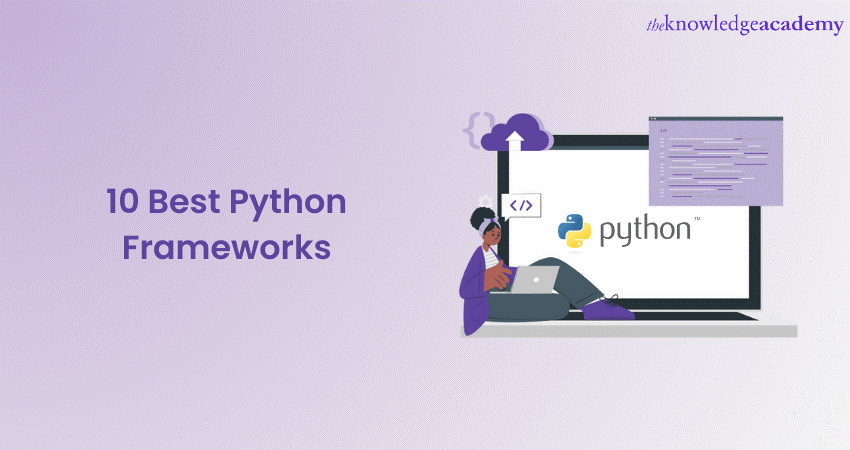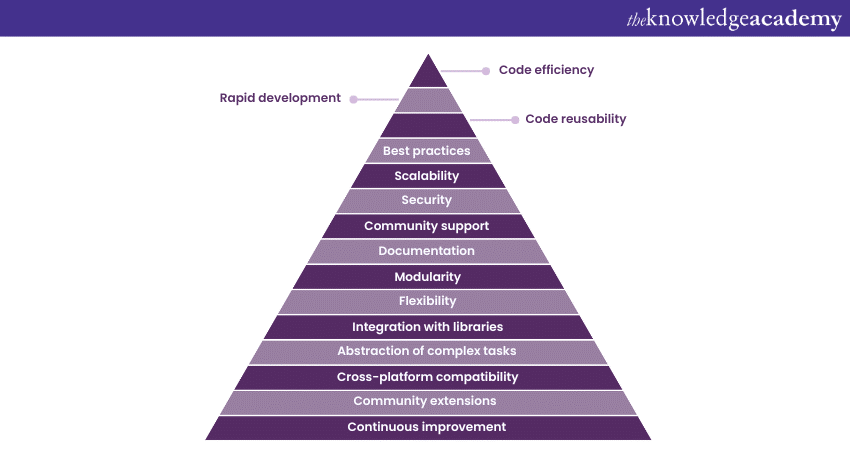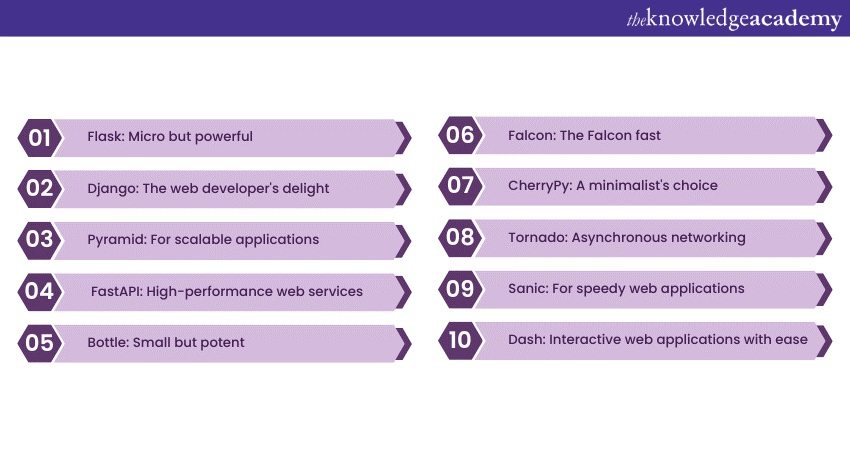We may not have the course you’re looking for. If you enquire or give us a call on +43 720 115337 and speak to our training experts, we may still be able to help with your training requirements.
Training Outcomes Within Your Budget!
We ensure quality, budget-alignment, and timely delivery by our expert instructors.

Python has emerged as a dominant language in the ever-evolving world of programming, rapidly gaining popularity due to its simplicity, versatility, and readability. Python Frameworks play a vital role in simplifying and accelerating the development process for programmers. In this blog, we will explore the top 10 Python Frameworks that can enhance your coding experience and empower you to build robust applications.
Table of Contents
1) What are Python Frameworks?
2) Why should you use Python Frameworks?
3) 10 Best Python Frameworks
a) Flask: Minimalistic but powerful
b) Django: The web developer's delight
c) Pyramid: For scalable applications
d) FastAPI: High-performance web services
e) Bottle: Small but potent
f) Falcon: The Fast and Lightweight API Framework
g) CherryPy: A minimalist's choice
h) Tornado: Asynchronous networking
i) Sanic: For speedy web applications
j) Dash: Interactive web applications with ease
4) Conclusion
What are Python Frameworks?
Python Frameworks are pre-built structures that provide a foundation for developing applications, streamlining the coding process and empowering developers to focus on building unique features. These frameworks offer a collection of tools, libraries, and best practices that facilitate the creation of web applications, APIs, and more.
By adhering to standard conventions and patterns, Python Frameworks enhance code efficiency, promote code reusability, and ensure better code organisation and maintainability. They come in various sizes and complexities, catering to projects of all scales. Python Frameworks empower developers with a structured approach to development, allowing them to build robust, scalable, and secure applications with ease, making Python an immensely popular language in the software development world.
Master Python Programming with our expert Python Programming Training. Sign up now!
Why should you use Python Frameworks?
Using Python Frameworks offers several compelling reasons why developers should consider adopting them in their projects:

1) Code efficiency: Python Frameworks provide pre-built components and standard patterns, reducing the need for repetitive code. Developers can emphasise writing business logic and unique features, resulting in a more efficient development process.
2) Rapid development: Python Frameworks come with ready-to-use tools and libraries, accelerating the development cycle. This allows developers to deliver projects faster, meeting tight deadlines and ensuring quick time-to-market.
3) Code reusability: With built-in Python Frameworks’ modules and components, developers can reuse code across projects. This not only saves time but also promotes code consistency and reduces the chances of errors.
4) Best practices: Top Python Frameworks enforce industry best practices, ensuring that developers follow standardised coding conventions. This improves code quality and maintainability.
5) Scalability: Many Python Frameworks are designed to handle projects of varying sizes. They offer scalable solutions, accommodating both small applications and large enterprise-level projects.
6) Security: Python Frameworks often incorporate security features and measures to protect against common vulnerabilities, safeguarding applications from potential threats.
7) Community support: Python Frameworks boast large and active communities. Developers can benefit from peer support, readily available resources, and frequent updates to stay abreast of the latest developments.
8) Documentation: Frameworks usually come with extensive documentation, making it easier for developers to learn and understand how to use them effectively.
9) Modularity: Python Frameworks encourage a modular approach to development, making it easier to maintain and update individual components without affecting the entire application.
10) Flexibility: Some Python Frameworks offer flexibility in terms of component selection, allowing developers to choose only the necessary elements for their specific projects.
11) Integration with libraries: Python has a vast ecosystem of third-party libraries. Python Frameworks often integrate seamlessly with these libraries, enabling developers to leverage additional functionalities effortlessly.
12) Abstraction of complex tasks: Python Frameworks abstract complex tasks, such as database interactions and URL routing, simplifying the development process and enabling developers to focus on core functionalities.
13) Cross-platform compatibility: Python Frameworks are compatible with multiple platforms, ensuring that applications can run on different operating systems without significant modifications.
14) Community extensions: Many Python Frameworks have extensive collections of community-driven extensions and plugins, expanding the range of features developers can incorporate into their applications.
15) Continuous improvement: Python Frameworks receive regular updates and improvements based on community feedback and emerging trends, ensuring they remain up-to-date and relevant.
Unlock your data potential with our Python Data Science Training. Join now!
10 Best Python Frameworks
This blog section will expand on 10 of the best Python Frameworks you can use to enhance your coding experience.

Flask: Minimalistic but powerful
The Flask is a lightweight and minimalist Python web framework that offers built-in functionality through extensions. It is designed to be simple and easy to use, making it a popular choice for beginners and experienced developers alike. Despite its minimalistic approach, Flask offers a robust set of tools and extensions that enable developers to build a variety of applications, from small projects to more complex ones.
One of the outstanding features of Flask is its flexibility. Unlike some other frameworks that come with a predefined structure, Flask allows developers to choose the components they need, giving them greater control over the development process. This level of customisation allows developers to create applications that precisely meet their requirements without unnecessary overhead.
Flask's excellent documentation and large community support further contribute to its popularity. New developers can quickly get updated with the framework, and experienced developers can find a wealth of resources to address any challenges they encounter.
Django: The web developer's delight
Django is a full-stack web framework that has earned its reputation as a developer's delight. It follows the "batteries-included" philosophy, providing developers with everything they need to build a web application from scratch. This feature-rich framework comes with an admin interface, an Object-Relational Mapping (ORM) system, and various built-in tools that streamline the development process.
One of Django's core principles is the "Don't Repeat Yourself" (DRY) approach. This means that developers can avoid redundant code and maintain a clean and efficient codebase. Django's emphasis on best practices and conventions ensures that developers build scalable and maintainable applications without sacrificing development speed.
The framework's built-in admin interface is a standout feature, as it enables developers to create a robust administration panel without much effort. This comes in handy when managing databases, user permissions, and other administrative tasks. Django's extensive documentation, tutorials, and large community make it easy for developers to find solutions to their problems and continuously improve their skills.
Master Django with our expert-led Python Django Training Course. Join today!
Pyramid: For scalable applications
Pyramid is a versatile and flexible Python Web Framework that excels in scalability. It is designed to accommodate projects of all sizes, from small applications to large-scale enterprise projects. Pyramid's philosophy is "start small and grow as needed," making it suitable for developers who value simplicity and the ability to extend the framework as their projects evolve.
The framework's minimalist design and clear structure make it easy for developers to work on complex applications without feeling overwhelmed. Pyramid promotes modularity and encourages developers to use components only when necessary, which contributes to better code organisation and maintainability.
Pyramid's "scaffolding" feature allows developers to generate project templates with just the essential components, providing a solid foundation to build upon. This helps developers to focus on writing code that fulfils the application's specific requirements rather than dealing with boilerplate code. For those who value scalability and flexibility in their projects, Pyramid is undoubtedly a compelling choice.
FastAPI: High-performance web services
FastAPI is a modern Python Framework that has gained immense popularity for its impressive speed and performance. It is designed to create high-performance web services and APIs with minimal overhead. FastAPI achieves this by leveraging Python-type hints to enable automatic data validation and code autocompletion in modern code editors.
One of FastAPI's key strengths is its asynchronous capabilities, allowing developers to handle multiple requests concurrently and efficiently. This makes it an ideal choice for building real-time applications and services that require speedy responses and high concurrency.
FastAPI's user-friendly documentation and interactive API documentation tool (Swagger UI and ReDoc) make it extremely developer friendly. With the ability to test API endpoints directly from the documentation, developers can easily verify their work and iterate quickly. Due to its performance-oriented nature and modern features, FastAPI has become a top choice for developers who prioritise speed and efficiency in their applications.
Bottle: Small but potent
Bottle is a micro-framework that demonstrates the power of simplicity. As one of the smallest Python Frameworks available, Bottle focuses on minimalism and ease of use. It comes with a built-in development server and requires no external dependencies, making it incredibly lightweight and perfect for quick prototyping.
Despite its small size, Bottle is surprisingly potent. It supports routing, templating, and even database integration through plugins. Developers can create RESTful APIs or full-fledged web applications with minimal effort. Bottle's minimalistic design encourages developers to write clean and concise code, ensuring that the application remains fast and efficient. For smaller-scale projects or when developers need to create simple applications rapidly, Bottle stands out as an excellent option.
Falcon: The fast and lightweight API framework
Falcon is a high-performance Python Framework designed to deliver blazing-fast APIs. It is optimised for speed and resource efficiency, making it an excellent choice for projects that demand rapid response times and high throughput.
Falcon achieves its impressive performance by using minimal abstractions and following RESTful principles closely. This ensures that the framework operates efficiently, allowing developers to handle a large number of requests with ease.
Falcon's minimalistic design encourages developers to write code that focuses on performance, making it a favourite among those who prioritise speed and efficiency. Additionally, Falcon provides a set of powerful middleware and hooks that can be used to extend the framework's functionality further. For developers working on projects with stringent performance requirements, Falcon is a top contender among Python Frameworks.
Want to unlock the power of data with Python? Sign up now for our Data Analysis and Visualisation Training Course!
CherryPy: A minimalist's choice
CherryPy is a minimalist Python web framework that places simplicity and resource efficiency at the forefront. Its design philosophy centres around allowing developers to do more with less code. As a result, CherryPy is an excellent choice for projects that demand a small memory footprint and low resource consumption.
Despite its minimalistic approach, CherryPy comes with built-in tools for handling HTTP requests, sessions, and static files. These features enable developers to build web applications with ease, all while maintaining a lean codebase. CherryPy's ease of use and straightforward design make it a great option for developers who appreciate simplicity and want to avoid unnecessary complexity in their projects.
Tornado: Asynchronous networking
Tornado is a Python web framework optimised for handling asynchronous networking tasks. It is designed for building applications that require high concurrency and real-time communication, such as web sockets and long polling.
Tornado's event-driven architecture allows it to efficiently handle thousands of open connections simultaneously, making it a solid choice for applications dealing with a large number of concurrent users.
While Tornado is renowned for its asynchronous capabilities, it also offers support for traditional request-response patterns. This versatility allows developers to choose the best approach for different parts of their applications, resulting in highly responsive and efficient solutions. Tornado's strengths lie in its ability to handle asynchronous networking tasks effectively, making it an excellent choice for developers who require real-time functionality and high concurrency in their applications.
Sanic: For speedy web applications
Sanic is a web framework known for its exceptional speed and performance. It is designed to handle high levels of concurrent requests efficiently, making it an excellent choice for building speedy web applications.
Sanic leverages Python's async/await syntax to handle asynchronous tasks, allowing it to respond to multiple requests concurrently. This asynchronous nature makes Sanic an ideal option for real-time applications and services that require immediate responses.
Despite its focus on speed, Sanic doesn't compromise on features. It comes with built-in support for routing, request handling, and response serialisation. Additionally, Sanic offers various extensions and middleware to enhance functionality and streamline development further. For projects that prioritise rapid response times and seamless user experiences, Sanic is a go-to Python Framework.
Dash: Interactive web applications with ease
Dash is a unique Python Framework that specialises in building interactive web applications. Developed by Plotly, Dash allows developers to create data-driven applications with rich visualisations and user-friendly interfaces.
The standout feature of Dash is its ability to seamlessly combine Python code with HTML, CSS, and JavaScript, enabling developers to create dynamic and responsive applications. By using Dash, developers can design interactive graphs, charts, and dashboards with ease, making it an excellent choice for data scientists and analysts.
With Dash, developers can harness the full potential of Python's data manipulation capabilities and create interactive web applications that convey complex insights and analyses in an accessible manner. For projects that require engaging data visualisations and intuitive user interfaces, Dash emerges as a compelling Python Framework choice.

Conclusion
Choosing the right Python Framework is essential for a successful development process. Consider factors such as project complexity, performance requirements, and your team's expertise to make an informed decision. Whether you opt for the simplicity of Flask, the robustness of Django, or the speed of FastAPI, Python Frameworks offer a wealth of tools to elevate your coding experience.
Unlock your coding potential with our comprehensive Programming Training Courses!
Frequently Asked Questions
Upcoming Programming & DevOps Resources Batches & Dates
Date
 Python Course
Python Course
Thu 14th Nov 2024
Mon 6th Jan 2025
Mon 13th Jan 2025
Mon 20th Jan 2025
Mon 27th Jan 2025
Mon 3rd Feb 2025
Mon 10th Feb 2025
Mon 17th Feb 2025
Mon 24th Feb 2025
Mon 3rd Mar 2025
Mon 10th Mar 2025
Mon 17th Mar 2025
Mon 24th Mar 2025
Mon 7th Apr 2025
Mon 14th Apr 2025
Mon 21st Apr 2025
Mon 28th Apr 2025
Mon 5th May 2025
Mon 12th May 2025
Mon 19th May 2025
Mon 26th May 2025
Mon 2nd Jun 2025
Mon 9th Jun 2025
Mon 16th Jun 2025
Mon 23rd Jun 2025
Mon 7th Jul 2025
Mon 14th Jul 2025
Mon 21st Jul 2025
Mon 28th Jul 2025
Mon 4th Aug 2025
Mon 11th Aug 2025
Mon 18th Aug 2025
Mon 25th Aug 2025
Mon 8th Sep 2025
Mon 15th Sep 2025
Mon 22nd Sep 2025
Mon 29th Sep 2025
Mon 6th Oct 2025
Mon 13th Oct 2025
Mon 20th Oct 2025
Mon 27th Oct 2025
Mon 3rd Nov 2025
Mon 10th Nov 2025
Mon 17th Nov 2025
Mon 24th Nov 2025
Mon 1st Dec 2025
Mon 8th Dec 2025
Mon 15th Dec 2025
Mon 22nd Dec 2025







 Top Rated Course
Top Rated Course


 If you wish to make any changes to your course, please
If you wish to make any changes to your course, please


